
Squash Court Heaters
Every squash court heating project we deliver has the same mission objective – heat players without obstructing the game or creating obstacles in the playing area. Our two approaches both use unobtrusive radiant heaters mounted up out the way.
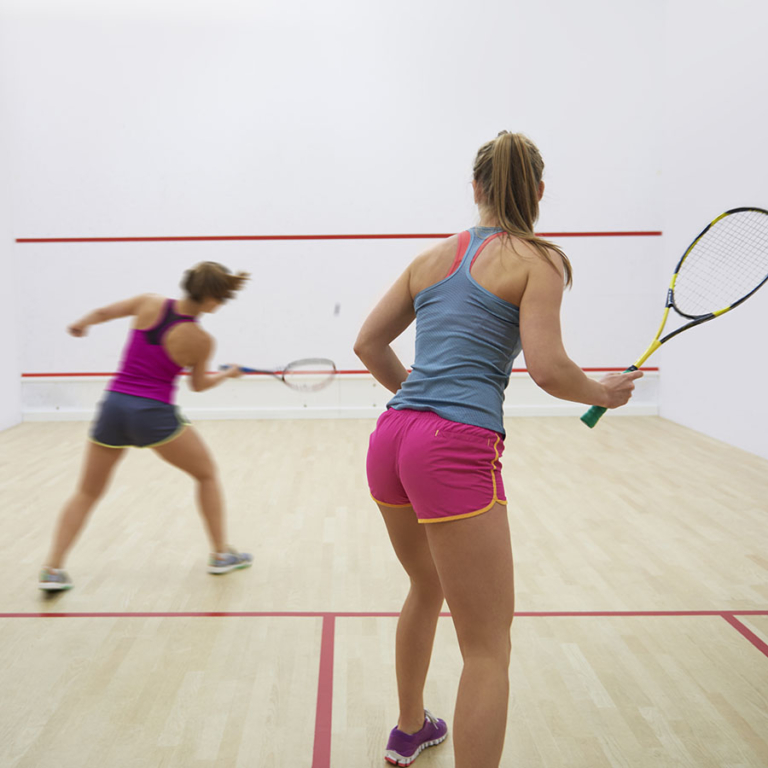
Heating Squash Courts
Probably the most important consideration when selecting a heating system for a squash court is not to interfere with the game itself. This consideration obviously precludes low level heating and means that heaters suspended from the roof are preferred.
A mounting height of around 6m effectively precludes the use of fan heaters. Even it were possible to project warm air this kind of distance, the fan noise would be very significant and the running costs would be prohibitive because of a phenomena known as temperature gradient. It is estimated that in a squash court heated by fan heaters, the air temperature will increase by around 2.5°C for every metre above floor level. Therefore, to maintain an air temperature of 20°C at floor level, in a 6m high squash court, the air temperature at ceiling level would be around 35°C. The net result is a large body of over-heated air that is expensive to generate and serves no useful purpose.
The solution to the problem lies in radiant heaters which will heat a squash court from high level without any noise and without creating a significant temperature gradient. Having decided on high level radiant heaters, we must know select between shortwave and long-wave heaters both of which have their advantages.
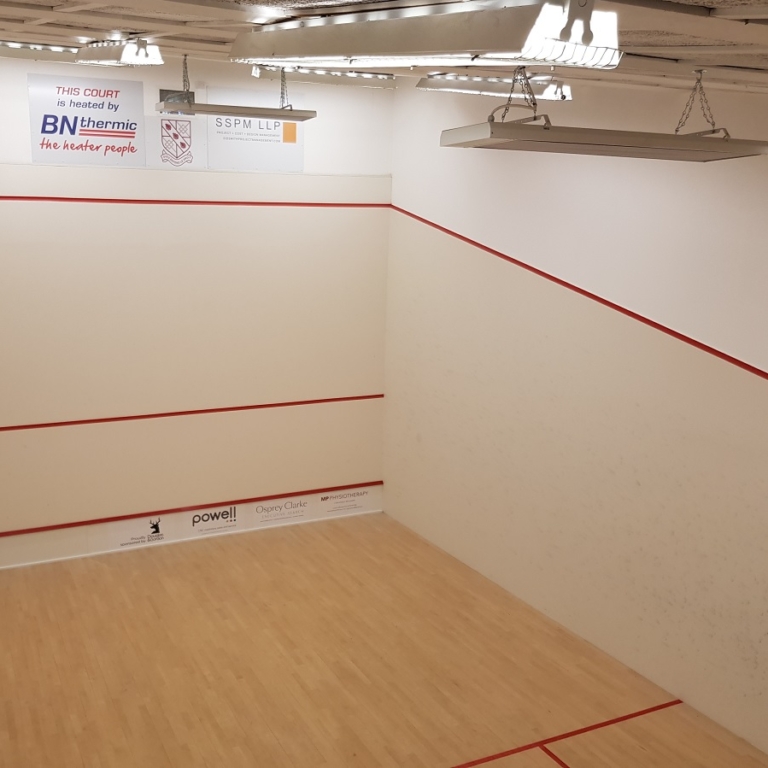
2 x 3.6kW radiant cassettes providing comfort heat to a squash court in Wandsworth, London
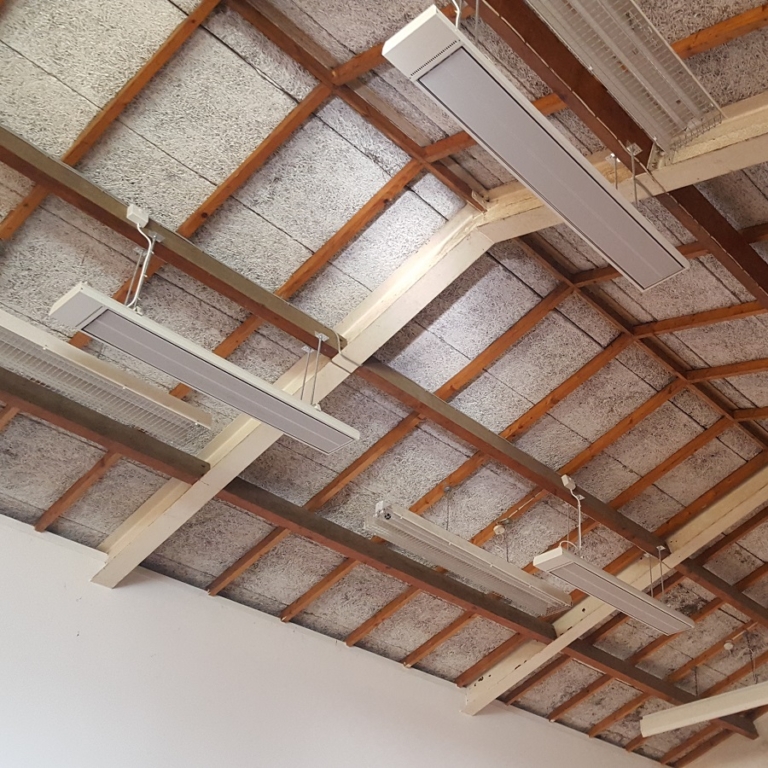
Radiant cassettes omit no light, draught or noise output – ideal for squash courts
Long-wave Radiant Cassettes
When squash courts are used on a more regular basis, long-wave radiant cassettes tend to be preferred. This system is designed to raise the air temperature within the squash court and will also warm the floor and walls more effectively than halogen heaters. Radiant cassettes do not produce any light output whatsoever.
A typical squash court would require two 3.6kW cassettes suspended at high level. Control would be by means of thermostat and programmable timer. Radiant cassettes are not instantly effective meaning some pre-heating will be required.
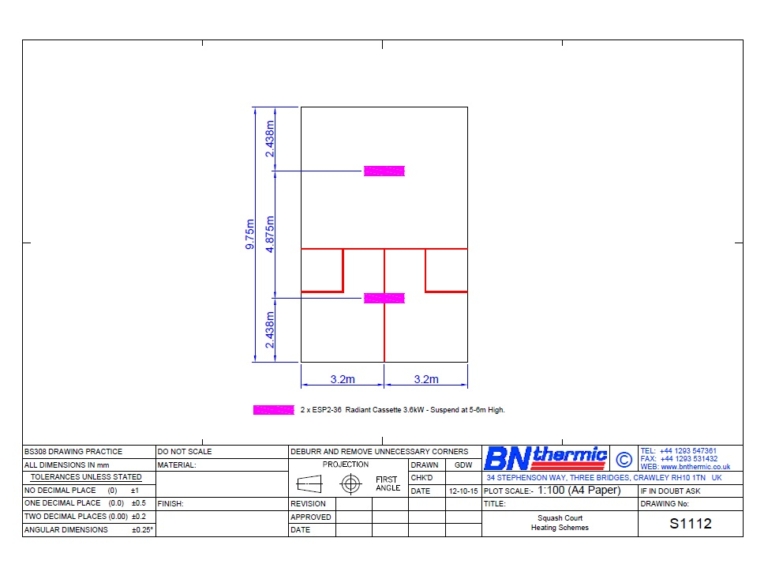
A typical design using radiant cassettes
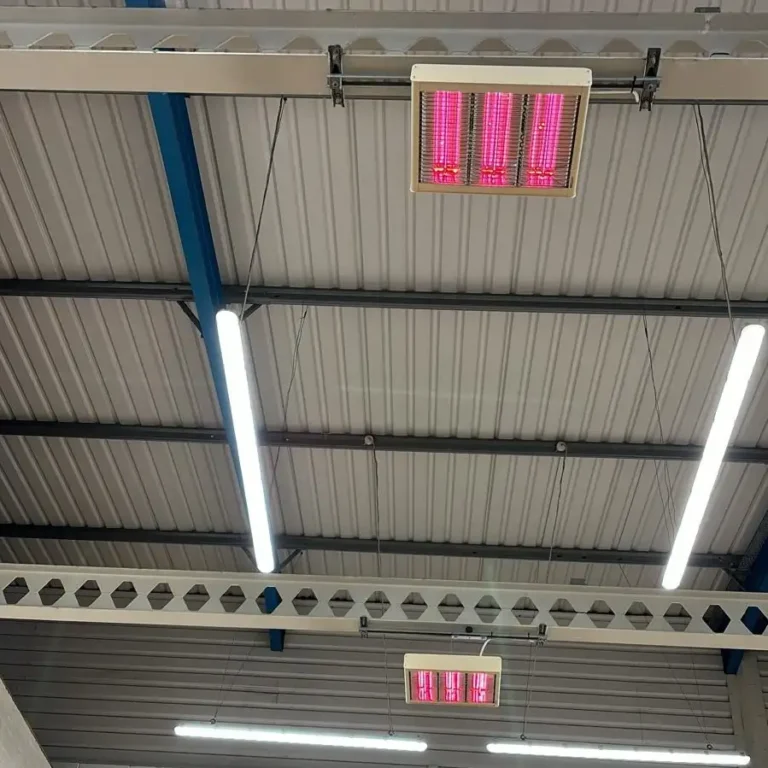
4.5kW magic lamp quartz halogen heaters providing comfort heat to players at Brooklands Squash Club in Sale, South Manchester
Shortwave Quartz Halogen Heaters
Halogen heaters emit shortwave energy which is absorbed directly by people (in this case squash players) and experienced as heat. The impact of halogen heaters on the surrounding air temperature will be minimal. Traditionally there has been a reluctance to use halogen heaters in sports facilities because of the light output associated with the technology. However, with the introduction of the BN Thermic’s Magic Lamp which produces a barely discernible glow, the benefits of halogen heaters are being reassessed.
A typical squash court could be heated using two 4.5kW halogen heaters suspended at around 6m above floor level. As the heaters are 100% effective the instant they are turned on, there is no need for preheating. Control by a time delay switch, will ensure that the heaters are not left on when the court is unoccupied.
Halogen heating, using heaters with BN Thermic’s new Magic Lamp, is recommended for courts with sporadic and irregular use.
Click here for more info on quartz halogen heaters

A typical design using quartz halogen heaters
Please note that the above recommendations apply to a typical squash court. We are aware that the buildings housing squash courts vary considerably and that a selection that is ideal for any given court may not be effective in different court. Please take into account the characteristics of a specific building before selecting a heating system. The engineers at BN Thermic are very experienced and are always on hand to assist.
Squash Court Heaters FAQs
-
How much does it cost to heat a squash court?
-
BN Thermic recommends two types of radiant heaters for heating squash. Longwave radiant cassettes (sometimes called far-infrared heaters) are generally preferred for regularly used squash courts whereas shortwave quartz halogen heaters are sometimes preferred when a facility is used intermittently.
Because quartz halogen heaters are instantly effective it is easy to calculate running costs. For a standard squash court, BN Thermic suggests installing two 4.5kW quartz halogen heater. Assuming an electric tariff of 15p per kW/h, this system will cost £1.35 per hour to run (2 heaters x 4.5 kW per heater x £0.15 tariff = £1.35). This figure is, of course, a maximum running cost as the players may decide to switch off the heaters at any point during a session.
It is not possible to provide the same simple calculation for a squash court heating system using longwave radiant cassettes. This is because some preheating will be required and once up to temperature, thermostatic control will bring the heating in and out at a frequency which depends on the thermostat set-point and the prevailing ambient temperature. What is safe to say is that if BN Thermic’s recommendation of two 3.6kW radiant cassettes is followed and assuming a tariff of 15p per kW/h, the running cost per hour cannot exceed £1.08 (2 heaters x 3.6kW per heater x £0.15 tariff = £1.08). On a cold day, you could expect this level of cost for the first hour but the running cost per hour will reduce thereafter as thermostat control takes over.
So to sum up, longwave radiant heaters tend to be cheaper to run for continuously used squash courts whereas quartz halogen heaters tend to be cheaper to run in intermittently used squash courts.
-
How can I control heaters in a squash court?
-
Selecting an appropriate control system is essential for maximum economy and comfort. The approach to control will depend entirely on the heating technology adopted.
Shortwave quartz halogen heaters are often seen as the best method of heating intermittently used squash courts because virtually no preheating is required. We generally recommend installing two 4.5kW heaters in each court.
The controller most frequently used to control these heaters is the TS-8 push button timer. This device is generally positioned just outside the court and has a button on its front face. Once this button is pushed, the heaters will come on for a period of time pre-set inside the timer (perhaps around 45 minutes). Once the pre-set time period has elapsed, the heaters will be automatically switched off until the button is pushed again. The heating can be switched off manually by simply pushing and holding the button.
Because the combined load of the two quartz halogen heaters is greater than the switching capacity of the TS-8 timer, a CON-50 (3-pole 50 amp contractor) must be added to the control circuit with a separate pole on the contactor switching each heater.
Using the TS-8 timer makes full use of the ‘instant heat’ characteristic of quartz halogen heaters by reducing the chances of an unoccupied squash court being heated.
Longwave radiant cassettes (sometimes referred to as far-infrared heaters) are usually preferred for more continuously used facilities. We generally recommend installing two 3.6kW cassettes in each court.
For this style of heating we recommend our PROSTAT4 thermostat and BBS remote-mounted temperature sensor. The sensor, which is very small and can be positioned inside the court, is connected to the PROSTAT4 thermostat which is generally positioned just outside the court. The PROSTAT4 has two temperature settings (low and high) both of which are adjustable. It also has a built-in rundown timer which is activated by pushing a button positioned on the front face.
The PROSTAT4 thermostat will hold the court at the low temperature (perhaps about 12°C) until the button is pushed. At this point the control switch-point will change over to the high setting (perhaps 18°C) and the temperature in the court will start to rise until it reaches the high temperature setting. The built-in run-down timer will change the control switch-point back to the low setting once the pre-set time period (perhaps 45 minutes) has elapsed. The ‘temperature boost’ command can be cancelled by simply pushing and holding the button. A contactor is not required as the combined load of the two cassettes is within the switching capacity of the thermostat.
The flexibility of the PROSTAT4 allows for a quick and predictable boost to the required temperature but avoids the need to maintain a high temperature while the squash court is not in use.
-
Are infrared heaters good for heating squash courts?
-
Yes, infrared heaters are ideal for heating squash courts. Both our quartz halogen heaters and our longwave radiant cassettes would be classed as infrared
-
Are squash court heaters noisy?
-
Both of BN Thermic’s recommended squash court heating systems operate silently. Depending on the control system used, there may be a need to use a contactor. These devices will emit an audible click when switching the heaters on and off. If absolutely silent operation is vital, this should be taken into account when selecting a mounting position for the contactor.
-
Can I use radiant heaters with no light output?
-
BN Thermic recommends two types of radiant heaters for heating squash courts. Longwave radiant cassettes (sometimes called far-infrared heaters) are generally preferred for regularly used squash courts whereas shortwave quartz halogen heaters are sometimes preferred when a facility is used intermittently.
Longwave radiant cassettes emit no light whatsoever.
Quartz halogen heaters inevitably produce some degree of light output. However BN Thermic’s Magic Lamp halogen heaters have been developed to provide all the output of a conventional halogen heater but with a fraction of the light output and zero glare. We always recommend Magic Lamp heaters for heating a squash court.